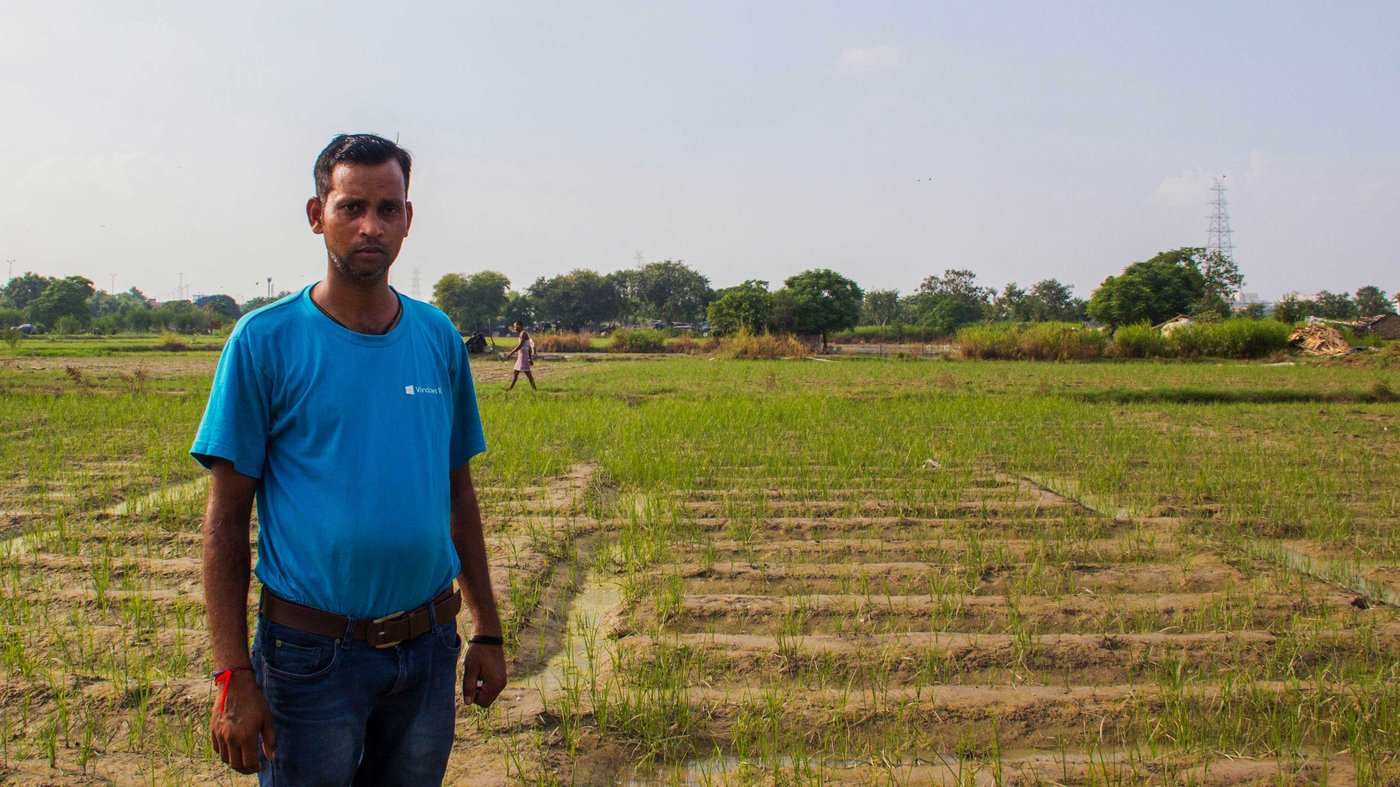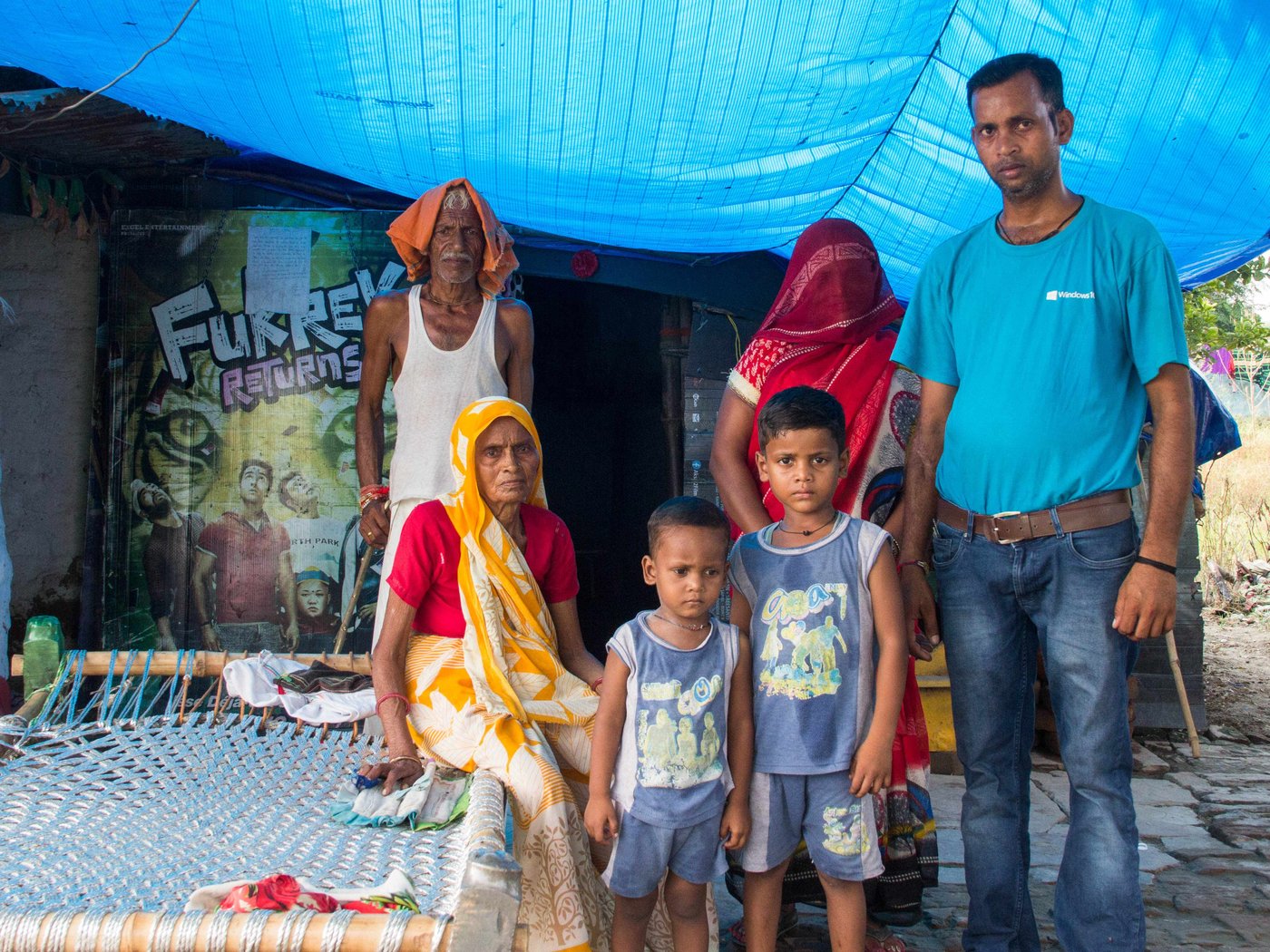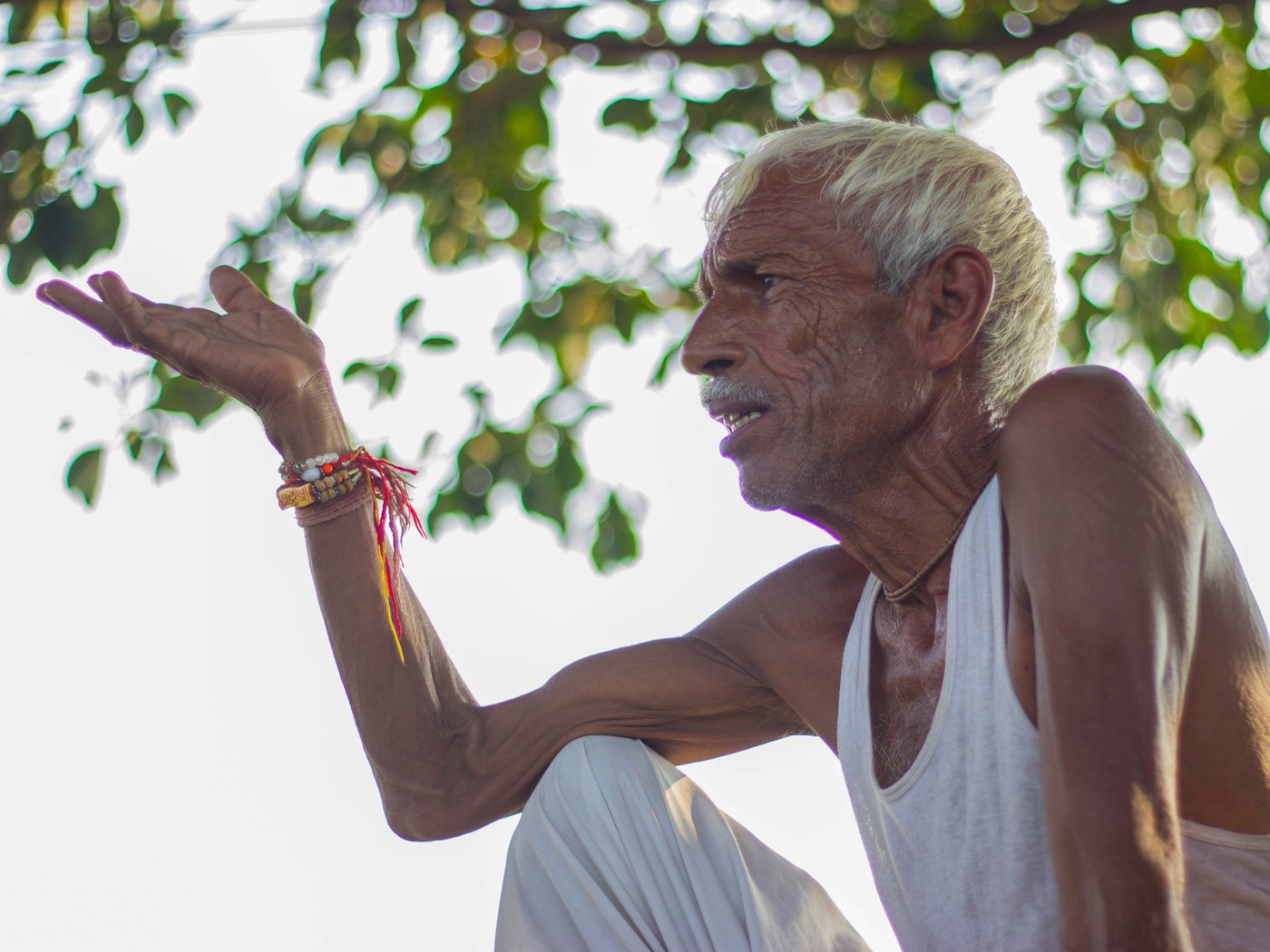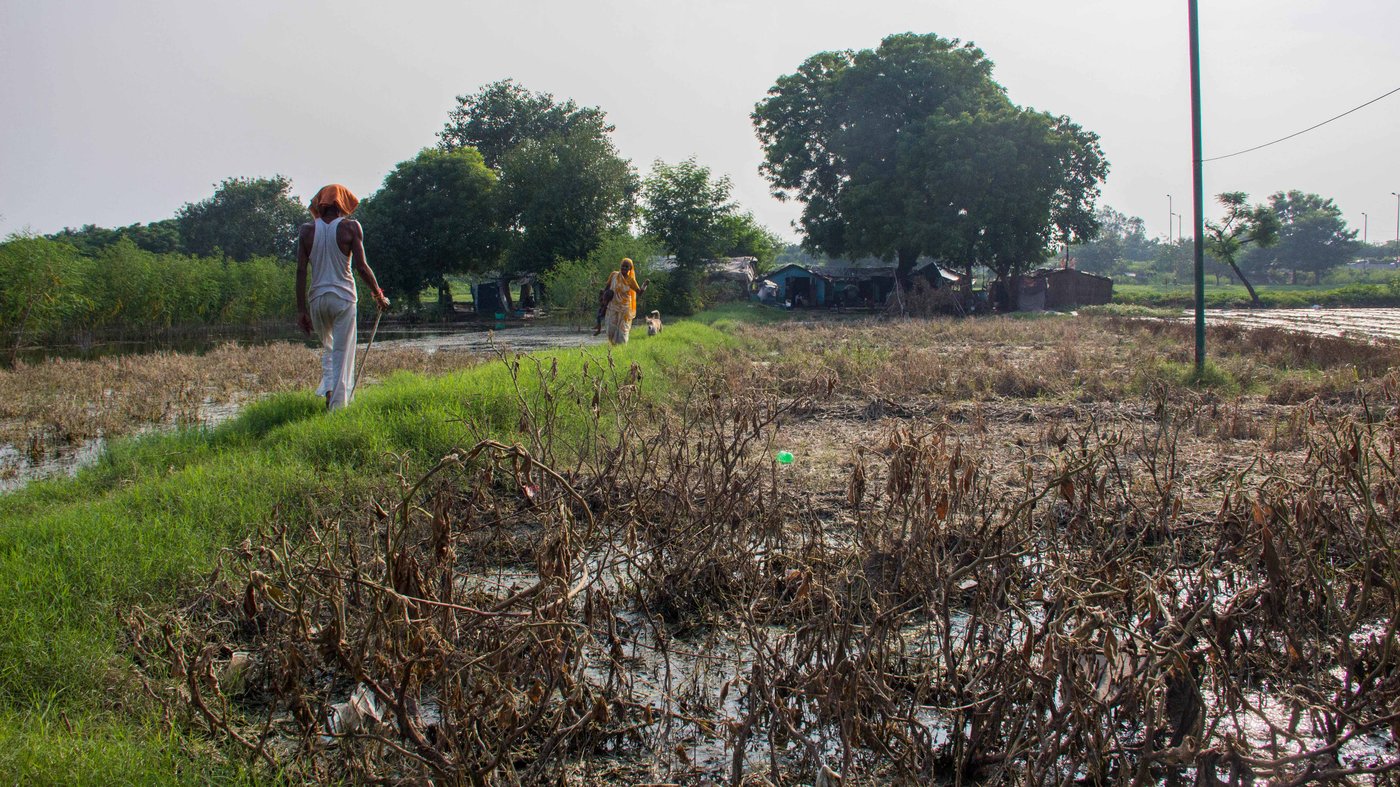Big city, small farmers, and a dying river
City farmers? Yes, sort of – in the national capital, struggling as a choked Yamuna river and the destruction of its floodplains spur the region’s climate crisis and devastates their livelihoods

Shalini Singh/PARI
"Insaan ab na jhagde se marega na ragade se
marega tho bhook aur pyas se.”
“Humankind will now die not of conflict or stress
But of hunger and thirst.”
So, it's not just science ringing alarm bells about climate change then. India’s literary epics had it nailed down ages ago, asserts 75-year-old Delhi farmer Shiv Shankar. He believes he is paraphrasing lines from the 16th century classic Ramcharitamanas (see video). Shankar may be a bit rusty in his reading of the classics, and you might find it difficult to locate those lines in the original Tulsidas poem. But the words of this farmer in the floodplains of the Yamuna river seem well suited to our own era.
Shankar, his family and many other cultivators describe, in painstaking detail, the many changes in temperature, weather and climate affecting what is one of the largest floodplains in an urban area anywhere. Just 22 of the 1,376 kilometres of the Yamuna flow through the National Capital Territory, and its 97 square kilometre floodplains account for barely 6.5 per cent of Delhi’s area. But that seemingly small presence has a big impact in balancing the climate, also functioning like nature’s thermostat for the capital.
Farmers here note the changes now underway in their own idiom. Till 25 years ago, says Shiv Shankar’s son Vijender Singh, people here started using light blankets by September. “Now,” says the 35-year-old, “winter doesn't start till December. Earlier Holi in March was marked by a very hot day. Now it's like celebrating the festival in winter."
Shiv Shankar, his son Vijender Singh (left) and other cultivators describe the many changes in temperature, weather and climate affecting the Yamuna floodplains. Vijender singh at his farm and with his wife Savitri Devi, their two sons, and Shiv Shankar (Photo: AIKANTIK BAG/PARI)
The lived experiences of Shankar’s family reflect those of other farmers here. Varying estimates say between 5,000 and 7,000 farmers reside along the Delhi shores of the Yamuna – the longest tributary of the Ganga and second greatest (after the Ghaghara) in terms of volume. The agriculturists here cultivate some 24,000 acres, much reduced from a few decades ago, they say. These are farmers in a big city, not of some remote rural region. They live precariously, with ‘development’ all the time undermining their existence. The National Green Tribunal (NGT) has been inundated with petitions protesting rampant illegal construction on the floodplains. And it isn’t just the cultivators who are worried.
“If the floodplains are concretised as has been happening,” says retired Indian Forest Service officer Manoj Misra, “Delhiwallas will be forced to leave the city because temperatures in both summer and winter will become extreme and unbearable.” Misra heads the Yamuna Jiye Abhiyan (Long Live Yamuna) movement founded in 2007. The YJA brought together seven of Delhi’s leading environmental organisations and concerned citizens, and works on saving the river and its ecosystem. “The city is becoming unliveable and will witness drastic migration. If it doesn't fix its air quality, (even) the embassies will move out.”
*****
Back in the floodplains, the erratic rains in the past few decades torment farmers and fishermen alike.
The communities dependent on the Yamuna river do still welcome the rains each year. Fishermen, because the excess water cleans out the river and allows fish to multiply, and farmers for whom it brings a layer of fresh fertile soil. “Zameen nayi bann jati hai, zameen palat jati hai [the land is rejuvenated and transformed by the monsoon rains],” Shankar explains. “This happened almost every year till 2000. It rains less now. Earlier monsoon would start in June. This time June and July were dry. Rains were late, affecting our crops.”
“The namak [alkaline content, not salt] rises in the soil when rain is less,” Shankar had told us when showing us around his fields. Delhi's alluvial soil is a result of the deposits left by the river over its floodplains. That soil had long supported growing sugarcane, rice, wheat, several other crops and vegetables. Three varieties of sugarcane – lalri, mirati, soratha – were a pride of the city till the late 19th century, says the Delhi Gazetteer.
“Zameen nayi bann jati hai,
zameen palat jati hai
[the land is rejuvenated and transformed by the monsoon rains],” Shankar explains.
The cane was used for making gur (jaggery) in kolhus (crushers). Till a decade ago, tiny makeshift shops and carts selling fresh sugarcane juice dotted Delhi’s street corners. “Then governments stopped allowing us to sell sugarcane juice, so cultivation stopped,” says Shankar. There have been official bans on the cane juice sellers – and court cases challenging them – since the 1990s. “Everyone knows sugarcane juice fights illness, beats the heat by cooling our system,” he asserts. “The soft drink companies got us banned. Their people lobbied with ministers and we were thrown out of business.”
And sometimes, weather extremes combine with political-administrative decisions to wreak havoc. The flooding of the Yamuna this year – when Haryana released water from the Hathni Kund barrage in August, it coincided with the rains in Delhi – destroyed several crops. Vijender shows us the shrunken chillies, shrivelled brinjals, and puny radish plants that will not bloom this season in their five bigha (one acre) plot here in Bela Estate (located just behind the national memorials of Rajghat and Shantivan).
This capital city has for long had a semi-arid climate. It was a south-east division of the agricultural state of Punjab before it became the British capital in 1911, and is surrounded by the Rajasthan desert to the west, Himalayan mountains towards the north and Indo-Gangetic plains to the east. (All regions also grappling with climate change today). This meant cold winters and scorching summers, with the monsoon providing a 3 to 4 month reprieve.
Now it’s more erratic. Delhi recorded a rainfall deficit of 38 per cent in the June-August season this year according to the India Meteorological Department. It received 404.1 mm rain against a normal of 648.9 mm. Simply put, Delhi saw its poorest monsoon in five years.
Monsoon patterns are changing and the rainfall is patchy, notes Himanshu Thakkar, coordinator, South Asia Network of Dams Rivers and People. “The number of rainy days has been depleting, though the quantum of rain may not go down. There is high intensity on the days it rains. Delhi has been changing and that will impact the Yamuna and its floodplains. Migrations, the number of vehicles on the road and air pollution – all have gone up, which has also sparked changes in surrounding areas of UP and Punjab. The micro climates [of a small area] impact the local climate.”

The Yamuna flooded this year when Haryana released water from the Hathni Kund barrage in August. (Photo: Shalini Singh/PARI)

The flooding of the Yamuna this year coincided with the rains in Delhi and destroyed several crops (Photo: Aikantik Bag/PARI)
'Jamna paar ke mattar le lo' (‘Buy these peas from across the Yamuna’) – the proud cry of vegetable sellers that once rang through the streets of Delhi fell silent somewhere in the 1980s. In the book Narratives of the Environment of Delhi (published by the Indian National Trust for Art and Cultural Heritage), old timers recall that the melons available in the city were like the 'Lukhnavi kharbuza' (Lucknow's watermelons). The juiciness of the fruit, grown on the sandy soils of the river, also depended on the prevailing air. The earlier melons were plain green and heavier (implying greater sweetness) and appeared once a season. Changes in cultivation practices have brought newer kinds of seeds. The melons are now smaller and striped – the new seeds give greater yields but smaller sizes.
The fresh mounds of water-chestnut – singhara – that vendors carted house to house two decades ago have all but vanished. They were grown around the Najafgarh jheel (lake). Today the Najafgarh Drain and the Delhi Gate Drain account for 63 per cent of the Yamuna’s pollution, says the website of the National Green Tribunal (NGT). “Singhara is grown in small water bodies,” says Baljeet Singh, 80, general secretary of the Delhi Peasants Cooperative Multipurpose Society. “People stopped cultivating it in Delhi because it needs the right amount of water – and plenty of patience.” The capital city today is rapidly running short on both – water and patience.
Farmers too want quicker yields from their lands, says Baljeet Singh. So they go for crops that take 2-3 months and can be grown 3-4 times a year like bhindi, beans, brinjal, radish, cauliflower. “New varieties of mooli (radish) seeds were developed two decades ago,” Vijender says. “Science has helped increase yields,” says Shankar. “We got some 45-50 quintals of mooli earlier [per acre]; now we can get four times as much. And we can grow it thrice a year.”

Vijender’s one acre plot in Bela Estate. (Photo: Aikantik Bag/PARI)

He showed us the shrunken chillies and shrivelled brinjals (right) that will not bloom this season (Photo: Aikantik Bag/PARI)

Photo: Aikantik Bag/PARI
Meanwhile, development of the concrete kind moves ahead rapidly in Delhi, not least in the floodplains. According to the Economic Survey of Delhi 2018-19, cropped area declined by almost 2 per cent each year between 2000 and 2018. Presently, 2.5 per cent of the city's population and nearly 25 per cent of its area (down from over 50 per cent in 1991) is rural. In the Master Plan 2021 for the capital, the Delhi Development Authority (DDA) plugs for complete urbanisation.
It’s pace of urbanisation – mainly, rapid construction activity, legal and illegal – means Delhi could be the most populous city in the world by 2030, according to UN estimates. The capital, with 20 million people presently, will have overtaken Tokyo (now 37 million) by then. It will also be one of 21 Indian cities to run out of groundwater by next year, says the Niti Aayog.
“Concretisation of the city,” says Manoj Misra, “means more land gets paved, less water percolation, less greenery... paved spaces absorb and release heat.”
In 1960 – when Shankar was 16 – Delhi saw an average of 178 days when the temperature reached at least 32 Celsius, according to an interactive tool on climate and global warming of the New York Times. In 2019, that’s 205 hotter days. By the end of this century, India’s capital city could go from experiencing less than six months of 32 C heat to over eight months of it each year. Human activity has much to do with that.

Shiv Shankar and his son Praveen Kumar start the watering process on their field (Photo: Aikantik Bag/PARI)

Shiv Shankar and his son Praveen Kumar start the watering process on their field (Photo: Shalini Singh/PARI)
Misra points to a difference of almost 4 degrees Celsius now in temperatures between Palam in south-west Delhi and the floodplains to its east. “If it's 45 Celsius in Palam, it can be around 40-41 C in the floodplain.” Within a megapolis, he says, “these floodplains are a gift.”
*****
Since nearly 80 per cent of Yamuna's pollution comes from the capital, as the NGT acknowledges, what would happen if it 'left' Delhi – a logical step for the aggrieved party in a toxic relationship. “Delhi exists because of the Yamuna, not the other way around,” says Misra. “Over 60 per cent of the drinking water for Delhi comes from the upstream diversion of the river into a parallel canal. The monsoon rescues the river. In the first wave or first flood pulse, the pollution is taken away from the river, in the second and third flood pulse, it recharges the groundwater of the city. The 5-10 yearly basis recharge is done by the river, no other agency can do that job. When we had flood-like situations in 2008, 2010 and 2013, the water was recharged for the next five years. Most Delhiwallas don't appreciate this.”
Healthy floodplains are key – they give water the space to spread out and slow down. They store excess water during floods, releasing it slowly into groundwater aquifers. This eventually helps recharge the river. Delhi was ravaged by its last devastating flood in 1978 when the Yamuna rose six feet above its official safety level, scores of people died, lakhs were affected, quite a few rendered homeless – not to forget the damage done to crops and other water bodies. It last breached this danger mark in 2013. According to the 'Yamuna River Project: New Delhi Urban Ecology' (led by the University of Virginia), steady encroachment of the floodplain has severe consequences. “The embankments will fall during a 100-year flood event, wiping out structures built in low lying areas of the floodplain and inundating east Delhi with water.”
Shiv Shankar explaining the changes in his farmland he has witnessed over the years (Photo: Aikantik Bag/PARI)
Farmers caution against further construction in the floodplains. “It will impact the water level tremendously,” says Shiv Shankar. “For every building, they will make basements for parking. They will plant fancy trees to get wood. If they put fruit trees – mango, guava, pomegranate, papaya – that will at least help people to eat and earn. And birds and animals get to eat too.”
Official figures show that since 1993, over Rs, 3,100 crores have been spent on cleaning the Yamuna. Why then, scoffs Baljeet Singh, “isn't the Yamuna clean today?”
It’s all coming together in Delhi – in the wrong way: unrelenting concretisation of every available inch in the city; uncontrolled construction on, and misuse of, the Yamuna floodplains; the choking of a great river with toxic pollutants; the massive changes in land use and new seeds, practices and technologies bringing an impact their users may not see; the destruction of nature’s thermostat; erratic monsoons, extraordinary levels of air pollution. It’s a deadly brew.
Shankar and his fellow farmers recognise some of its ingredients. “How many roads will you build?” he asks. “The more you concretise, the more heat the ground absorbs. Nature’s mountains – even they allow earth to get recharged during the rains. The mountains humans have built in concrete do not allow the earth to breathe or recharge or retain and use the rains. How will you grow food if there is no water?”
PARI’s nationwide reporting project on climate change is part of a UNDP-supported initiative to capture that phenomenon through the voices and lived experience of ordinary people. These stories are simultaneously available on www.ruralindiaonline.org
Want to republish this article? Please write to zahra@ruralindiaonline.org with a cc to namita@ruralindiaonline.org.

 Locations
Locations


